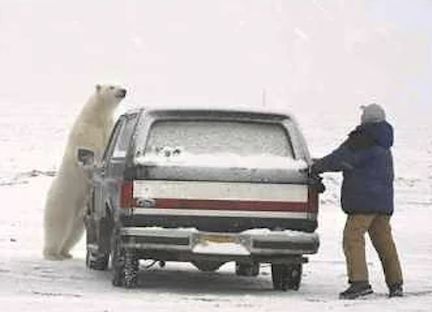Of Humpback Whales and Songs of Deliverance
Humans and birds aren't the only creatures that sing. Whales sing too. In fact, the songs of humpback whales are some of the most complex arrangements in the animal kingdom. Their ditties consist of vast roars, deep bellows, and groans interspersed with interesting sighs, chirps, whistles, and squawks.Their songs range from five to 30 minutes long.
Once a whale is done singing, it will surface to take a breath, then descend to about 50 feet, where it holds its position with its head down and then repeats the song verbatim, again and again, sometimes for hours on end.

As far as we know, only the males sing, and humpbacks in the same region of the ocean sing the same song. Each year, their songs change somewhat, as though they are experimenting with different arrangements.
The song of the humpback reaches sound levels up to 180 decibels — that's louder than a rocket blasting off! And researchers believe that some of these low-frequency sounds can travel more than 3,000 miles!
Did you know that the Bible says the loud voice of an angel can reach all around the world? "Then I saw another angel flying in the midst of heaven, having the everlasting gospel to preach to those who dwell on the earth to every nation, tribe, tongue, and people - saying with a loud voice, 'Fear God and give glory to Him, for the hour of His judgment has come; and worship Him who made heaven and earth, the sea and springs of water'" (Revelation 14:6, 7).
The Three Angels of Revelation 14 represent God's church of these last days. We, as members of His church are responsible for proclaiming the Good News of the Everlasting Gospel to the entire world. Like the mighty whales, we boldly proclaim, as the psalmist calls them, "songs of deliverance" to a needy world.
Sometimes the melodies will change, as we continually reassess how best to meet the current needs of our communities and our world. But the message will always be the same ... the Good News of the Gospel of Jesus Chirst, come "to seek and to save those who are lost" (Luke 19:10, NLT).
Polar Bear One Another's Burdens
Perhaps you've seen the many social media posts (on Facebook, Instagram, etc), claiming that it is illegal to lock your car doors in the town of Churchill, Manitoba, Canada. But is it true? Well, yes and no ...
“There is no current law in place in Churchill that requires residents to not lock their vehicle doors,” Paul Manaigre, a spokesman for the RCMP in Manitoba, the province that Churchill belongs to, told AFP by email.
But the claim is grounded in some truth. Churchill, population 900, is known for frequent polar bear visits when the ice on the nearby Hudson Bay melts in the warmer months.
According to Manaigre, “It is common knowledge that polar bears may enter the community at any time, and those that may need to seek shelter from a polar bear can use a vehicle, as most people will leave them unlocked for this purpose.”

“It’s just a common practice to leave your doors open. I never lock my car doors in my personal vehicle,” Erica Gillis, a research technician at the Churchill Northern Studies Centre, told AFP.
She explained that this custom is partly due to the polar bear threat, but also because Churchill is a remote, isolated community not accessible by road. “There aren’t many roads other than the main street,” Gillis added.
There is an estimated population of 935 polar bears in the western Hudson Bay area, where Churchill sits. As a response to the frequent bear visits, the town established a polar bear alert program. A team tranquilizes the animals if they enter town and takes them to a polar bear holding center, known by locals as the polar bear jail.
Thanks to the program, the Manitoba town has not had a bear-related fatality since the early 1980s.
The comments on the social pages range from disbelief and fear, to fancy and sarcasim. But the comment that seemed to jump off the page ...
Now THAT'S community!
Indeed, that IS community: A tight knit group of people, all looking out for one another, intentionally making provision for one another's refuge and safety. My car is your car. In this village, in this community, we protect and care for one another.
Appropriately and ironically, this little town is call "CHURCHill" (wink), where they collectively "bear" one another's burdens.
In our wild and unruly world where all manner of "bears" are seemingly out to get us, the church is called to be that village where the doors of refuge are always unlocked, waiting to welcome us in to help us stand against the lurking dangers. Now THAT'S community!
"Bear one another's burdens, and so fulfill the law of Christ." (Galatians 6:2, ESV).
"Let each of you look not only to his own interests, but also to the interests of others, (Philippians 2:4, ESV).
"Let no one seek his own good, but the good of his neighbor," (1 Corinthians 10:24, ESV).
"Do not neglect to do good and to share what you have, for such sacrifices are pleasing to God," (Hebrews 13:16, ESV).
Restoring the Church of God
On April 15, 2019, thousands of horrified Parsians and tourists looked on, many with tears in their eyes as Notre Dame was on fire. Many of us remember watching the fire as well, seeing flames shoot into the air and rapidly spread over the Gothic building’s roof, known as “The Forest” because of its long planks of 800-year-old wood.
The next day, the French President vowed to rebuild the edifice within five years. While many thought a complete restoration would take decades, five years later, the historic renovation is nearly 90% complete. 2,000 oak trees were sourced from forests around Europe for the rebuild. Some of them are up to 400 years old. They were left to dry for 12 to 19 months before the carpenters used them. The estimated cost was $760 million. As of April 15, 2024, 340,000 donors from more than 150 countries have donated around $895 million.

Ahead of the 2024 Olympics in Paris, work by this team of carpenters, scaffolding experts, professional climbers, organ mechanics, and others continues at the cathedral. While most of the modern building methods are being employed, there are tools that were re-created on site to match those used a thousand years ago by the original builderss.
We live in perilous times, when even the very fabric of the church is being burned to the ground by divisiveness, wokeness, radicalism, religious persecution, and the like.
If we, as a people are so inspired by God to rebuild and invest in a physical church edifice, how much more should we be inspired to invest in rebuilding His true church, the Body of Christ.
Our foundation is immovable, for it is Christ Himself! (1 Corinthians 3:11). We, as believers, are the very composition of that great, spiritual structure: "From whom the whole body, joined and held together by every joint with which it is equipped, when each part is working properly, makes the body grow so that it builds itself up in love" (Ephesians 4:16, ESV).
And let us look to Scripture to resurrect (pun intended) the very tools which were used from the beginning of the Church's construction, putting on love "which binds everything together in perfect harmony" (Colossians 3:14, ESV).
1 Corinthians 3:
9 For we are co-workers in God’s service; you are God’s field, God’s building.
10 By the grace God has given me, I laid a foundation as a wise builder, and someone else is building on it. But each one should build with care. 11 For no one can lay any foundation other than the one already laid, which is Jesus Christ. 12 If anyone builds on this foundation using gold, silver, costly stones, wood, hay or straw, 13 their work will be shown for what it is, because the Day will bring it to light. It will be revealed with fire, and the fire will test the quality of each person’s work. 14 If what has been built survives, the builder will receive a reward. 15 If it is burned up, the builder will suffer loss but yet will be saved—even though only as one escaping through the flames.
16 Don’t you know that you yourselves are God’s temple and that God’s Spirit dwells in your midst? 17 If anyone destroys God’s temple, God will destroy that person; for God’s temple is sacred, and you together are that temple.